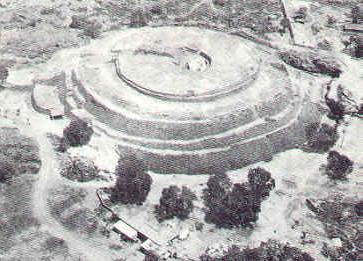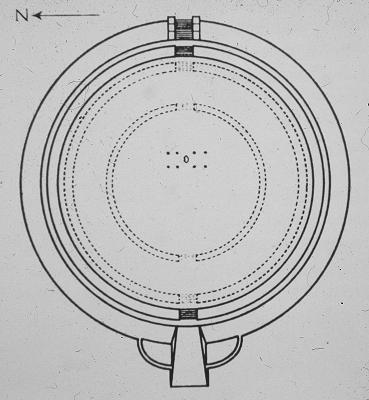|
Location:
Valley of Mexico, Mexico. |
Grid Reference:
19� 18' 06" N, 99� 10' 54" W. |

 Cuicuilco:
(Circular Pyramid).
Cuicuilco:
(Circular Pyramid).
Cuicuilco is an important early Mesoamerican site which
is said to have developed in Central Mexico during the
Formative period, between 700 B.C. and A.D. 400, when it
was totally destroyed by a volcanic eruption.
According to translations of ancient
Nahuatl, Cuicuilco is variously interpreted as the 'Place
of Power' or the 'Place of the Rainbow' and the
'place where they make songs and dances'.
Cuicuilco is the only conical or circular pyramid in Mesoamerica,
and the earliest.
Although the pyramid was
discovered in 1920 by archaeologist Manuel Gamio, the first investigations at
Cuicuilco were carried out by Byron
Cumming, between 1923 and 1924,
which led to the discovery of the
civic core of the site and the main
pyramid. In 1968, during the
construction work for a swimming
pool for the Olympics, other
smaller, rectangular pyramids were
discovered.
The most important building of Cuicuilco is
the
circular pyramid made of four platforms and covered in stone, 27 m (ca 90 ft.) high and 80
m (260 ft.) in diameter. A series of superimposed altars were
found atop the pyramid. These were painted in red with traces of
haematite. Next to the Pyramid of Cuicuilco was discovered and
excavated the ancient city of Ticoman.
The first stone monument on the Mexican plateau
is the pyramid of Cuicuilco, near Mexico City. In fact, it is
a truncated cone, with a stone core; the rest is made of
sun-dried brick with a stone facing. It shows the main features
of the Mexican pyramids as they were developed in later times.
(4)
Dating The
Cuicuilco Pyramid.
Cumming's dated the
pyramid at around 6,000 BC, based on the depth of the Lava Pedigral',
which is up to 10m deep in places. Knowing the date of the last
eruption, and seeing that there was approximately 3 times more lava
below, he concluded that it must be three times older. It is now
known that the earlier eruptions occurred over a 500 year period.
By 200 BC, Cuicuilco was one of the most important and larger centres
in Central Mexico, and it has been estimated that
its area covered approximately 400 ha, with a
population of 20,000 people. At around 60 BC a first
eruption of the volcano Xitli covered most of the
centre and its cultivated fields, severely affecting
the life of the community. Cuicuilco, however,
continued to live as a smaller centre until 400 AD,
when a final volcanic eruption definitely buried the
site. Radiocarbon dating of the Pyramid was determined by Fergusson and
Libby, in 1963. The test for the base of the sediments gave an age of
2,200 years B.P. Radiocarbon dates from below the lava flow date
the original construction of the building between 800 and 600 BC.
(2) Discovery of a
campfire at the base of the building has placed the earliest
occupation of the area at 2,000 BC (7)
The Cuicuilco pyramid was one of the first true
urban centres in the Basin of Mexico. Its construction started a few centuries BC, during the Late Pre-classic
period. The pyramid is partially covered by a basaltic
lava flow produced by the Xitle monogenetic volcano. New
work around the pyramid and the volcano together with new radiocarbon dates indicate that the pyramid and nearby settlements were abandoned as a direct consequence of the volcanic activity of
Xitle. The new dates, obtained
from material which clearly is contemporaneous with the
volcanic activity, suggest that the eruption took place
around 1670 years BP, some 300 years later than
previously thought. (3)
"He with the navel" (Xitli), according to
the scribe Alva Ixtlilxochitl, "opened the earth and swept
everything in its path, on the day Ahui-Quiahuitl, in the year
8-Tecpatl," this translates into April 24 of 76 A.D." (1)
Archaeology has concluded that
Cuicuilco was a prominent community prior to the emergence of
Teotihuacan as an urban centre, noting the six small communities
which eventually combined to become Teotihuacan were founded and
showing evidence of modest growth during the time Cuicuilco was
building pyramids and public monuments. The city seems to have been
abandoned at around the same time that Teotihuacan entered its main
growth phase, following the eruption of the Xitle volcano.
The site of Cuicuilco is covered
by dense volcanic lava field known as the Pedegral de San
Angel. The lava covers an area of approximately 80km2, including the
foothills of the Ajusco mountain range and extending down to the
nearby lake shore. A 1956 study concluded that the uneven lave
deposits, reaching a depth of over 10m in areas, were a major factor
in the preservation of Cuicuilco. The site is also inside a modern
urban area, and is partially covered by buildings associated with
the National University of Mexico. Only partial archaeological
investigation has been possible and modern techniques have damaged
the prehistoric city. Several 1990 archaeological finds at
Cuicuilco, were destroyed for the construction of a multi-storied
office complex. Consequently the true size and complexity of the
original site may now be impossible to ascertain.
(5)

A stela discovered near the pyramid of Cuicuilco is suggested as
proof an ancient connection between the Cuicuilco culture and that
of the contemporary Olmecs, considered until recently the mother
culture of Mesoamerica. (6)
Of great
surprise to archaeologists was the fact that the entire structure of
the pyramid was found to have been covered with a laayer of yellow
earth just over 1metre thick, suggesting that the settlers had known
in advance of the eruption and had attempted to preserve the
building. Numerous female figurines were found, very similar if not
exactly equal to those found in many Palaeolithic European sites, as
well as large menhirs over a metre tall which are believed to have
come from the collapse of other structures of the pyramid. In
addition, there are large numbers of burials arranged radially
around the pyramid.
(7)
(Other
Mexican Sites)
(Other
Pyramids)
|

